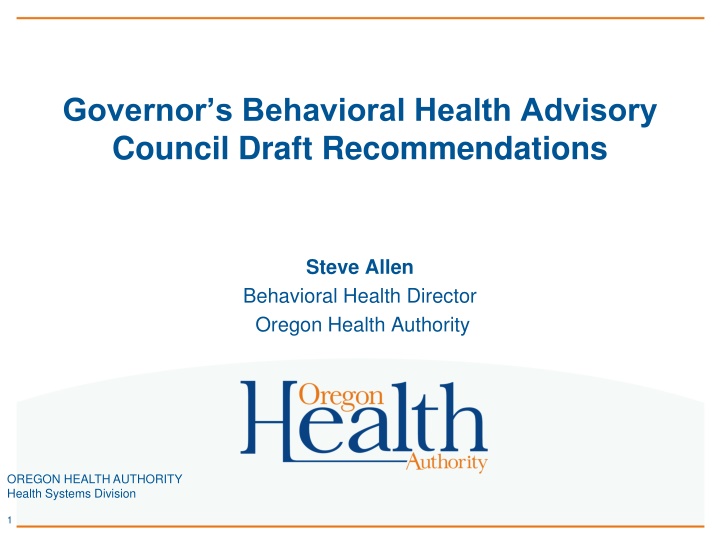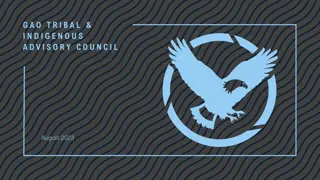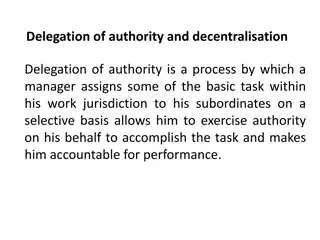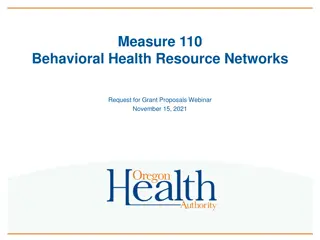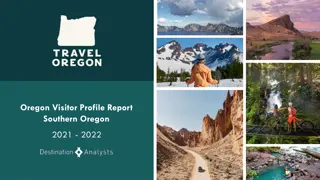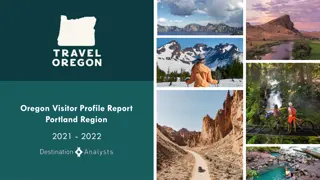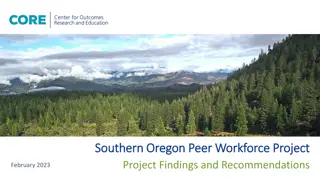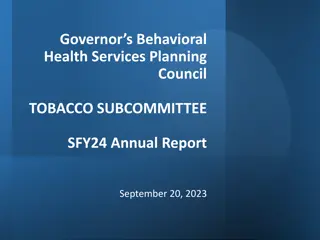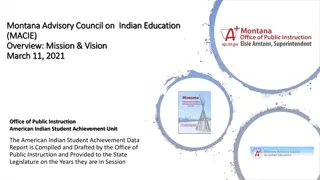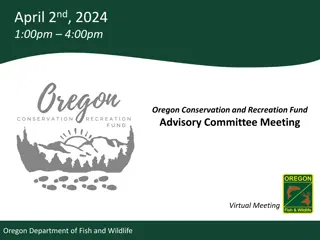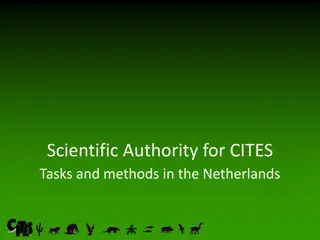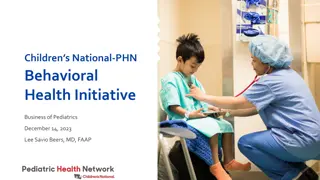Oregon Health Authority's Behavioral Health Advisory Council Recommendations
Oregon Health Authority's Behavioral Health Advisory Council (GBHAC) is focused on improving access to effective behavioral health services for adults and transitional-aged youth with mental illness and substance use disorders. The council's recommendations aim to advance health equity, early detection and treatment, timely access to care, individualized treatment, affordable housing, and an improved behavioral health workforce. The council's work has been interrupted by COVID-19 but has continued through shared learning activities and affinity group meetings.
Download Presentation

Please find below an Image/Link to download the presentation.
The content on the website is provided AS IS for your information and personal use only. It may not be sold, licensed, or shared on other websites without obtaining consent from the author.If you encounter any issues during the download, it is possible that the publisher has removed the file from their server.
You are allowed to download the files provided on this website for personal or commercial use, subject to the condition that they are used lawfully. All files are the property of their respective owners.
The content on the website is provided AS IS for your information and personal use only. It may not be sold, licensed, or shared on other websites without obtaining consent from the author.
E N D
Presentation Transcript
Governors Behavioral Health Advisory Council Draft Recommendations Steve Allen Behavioral Health Director Oregon Health Authority OREGON HEALTH AUTHORITY Health Systems Division 1
Governors Behavioral Health Advisory Council (GBHAC) 35 member council (+12 agency members) est. by Executive Order Meets monthly from October 2019 to October 2020 Council timeline interrupted between April and June 2020 due to COVID-19 Scope/Target Population: Adults with serious mental illness and co-occurring substance use disorders Transition-aged youth (age 12+) OREGON HEALTH AUTHORITY Health Systems Division 2
GBHAC Charge GBHAC will develop recommendations aimed at improving access to effective BH services and supports for all Oregon adults and transitional-aged youth with serious mental illness or co-occurring mental illness and SUD. The BHAC will recommend specific actions and investments necessary to improve access to behavioral health care that is responsive to people s individual needs and characteristics, and improves health outcomes. Council to provide specific recommendations in order to ensure: Health equity is advanced within the state s behavioral health system Mental health and SUD are detected early and treated effectively Youth and adults with serious mental illness have timely access to the full continuum of behavioral health care Youth and adults with serious mental illness can receive treatment that is responsive to their individual needs and leads to meaningful improvements in their lives People with serious mental illness have access to affordable housing that offers independence and is close to community resources The supply, distribution, and diversity of the BH workforce is improved to provide appropriate levels of care and access to care in the community 3
The Council began its work through shared learning activities and reviewing recommendations from other workgroups and commissions, including the Alcohol and Drug Policy Commission Strategic Plan. OREGON HEALTH AUTHORITY Health Systems Division 4
COVID-19 Interruption of GBHAC Work Oct- Dec. Jan- Mar. Aug.- Sep. April May June July Shared learning/ group building 1st set of affinity group meetings Full GBHAC consider 1st set of recs (Planned) 2nd set of affinity groups (Planned) 2nd set of affinity groups (Planned) Reset and full council discussion 1st set of affinity groups reconvene and prioritize and full GBHAC deliberates COVID-19 Break Reset Note: 1st set of affinity groups refer to housing, workforce, and programs and services. The 2nd set refers to data and outcomes, payment and incentives, and accountability. OREGON HEALTH AUTHORITY Health Systems Division 6
August Deliberations This month, the GBHAC s affinity groups have been asked to prioritize their recommendations based on the prioritization of racial equity and unknown budget climate going into the 2021-2023 budget cycle. Groups were asked: What recommendations are budget neutral? What recommendations are explicitly focused on persons of color and tribal communities? How does each recommendation impact equity? If we don t know the impact, what are the barriers to knowing that? What aligns with other Affinity Group recommendations? Is there anything to take off the table for consideration as a top priority? The following prioritized recommendations came out of those conversations and are currently being considered by full GBHAC. OREGON HEALTH AUTHORITY Health Systems Division 7
Programs and Services Recommendations Budget Neutral Recs: Endorsed OHA s ongoing development of a statewide crisis and behavioral health support tool called Oregon Behavioral Health Access System through CARES Act coronavirus relief funding. The system will include an all-inclusive website that connects individuals to all BH services, including substance use residential services, crisis, outpatient, inpatient mental health, & community-based services. Recs with Budget Impact (prioritized in order): The group s primary priority are programs that are directly responsive to and driven by persons of color, tribes, and people of lived experience. Expansion of programs for Youth/Young Adults (EASA/Youth HUBS) Funding for Medicaid reimbursement for Tribal Based Practice A state-funded pilot to create three non-clinical peer-run respite centers, including a culturally specific site. 8
Programs and Services Recs Continued The Affinity Group s second priority is to fund Certified Community Behavioral Health Clinic demonstration sites. The agency would work with CCBHC organizations, advocates, CCOs and others to look at a sustainable funding model. The goal would be to refine the model to further develop service array, culturally responsive service delivery, and outcome measurement to reinforce comprehensive outpatient services (inclusive of substance use services) that are simple, meaningful, and responsive. The Affinity Group s third priority is a scaled-down agency request budget recommendation to increase support for community restoration for defendants who do not have fitness to proceed in a criminal matter ( aid and assist defendants). 9
Housing Recommendations Budget Neutral Recs: Transfer the Housing for Mental Health Fund (ORS 458.380) to the Oregon Health Authority from Oregon Housing and Community Services. This increases the Fund s flexibility to provide incentive funding for new housing ranging from licensed levels of care to short- term respite to independent and integrated housing. Direct OHA to include CCO requirements for housing navigation and Social Determinants of Health through care coordination. Recs with Budget Impact (prioritized in order): The first priority is to address Residential Support Needs: Increase OHA funding for Rental Assistance with barrier busting funds and wraparound support Create a flexible residential fund to fill gaps in the residential continuum for people of color and tribal communities, including recovery housing. 10
Housing Recommendations Continued The second priority is to develop additional Residential Treatment Facility and Secured Residential Treatment Facility capacity. Expand Young Adult in Transition Residential System with four additional five-bed Residential Treatment Homes (RTH) and a 10-bed Secure Residential Treatment Facility (SRTF) specializing in the young adult population (age 17.5 25). Support OHA funding for three SRTFs to increase the number of facilities to serve the aid and assist population. The third priority is to support Peer Respite Pilot as recommended by the Programs and Services Affinity Group. 11
Workforce Recommendations Budget Neutral Recs: The group supports rule revision to reduce administrative burden: Revise 309 rules to reduce admin. burden and to be consistent with the 410 rules that apply to behavioral health staff operating in primary care and other settings. Recs with Budget Impact (prioritized in order): The first priority is to create a behavioral health incentive fund for recruitment and retention of the workforce to increase the number of persons of color, tribal communities and rurally based people in the behavioral health workforce. Increase capacity through bachelor s and master s level education and retention bonuses Expand funding for/incentivize culturally specific peers, THWs, licensed / certified providers, and licensed prescribers. Incentivize all levels of workforce 12
Workforce Recommendations Continued The Affinity Group s second priority is to implement and sustain culturally based practices, including promising and non-traditional practices. The Affinity Group notes that implementation must reimburse equitably with other behavioral health services and consider prioritizing services and supports outside of the dominant culture paradigm. The Affinity Group s third priority is to focus on training the behavioral health workforce. All behavioral health workforce should be trained in the following: trauma informed care, culturally specific/responsive, anti-racism, equity based, interdisciplinary (including working with peers), and co- occurring disorders (mental health and substance use disorder). Develop an outcomes-based system to demonstrate anti-racism and equity training. 13
Alignment of GBHAC Priorities and ADPC Strategic Plan Programs and Services CCBHC (inclusive of substance use services) could increase ability to maximize and expand existing effective treatment capacity. Furthermore, the integrated nature of CCBHC will help to better identify persons at risk of or experiencing health, social, or legal consequences from AOD use and provide them with appropriate intermediaries to facilitate access to needed treatment services. The statewide crisis systems will increase ability of intermediaries and practitioners to connect clients to same day access to appropriate levels of treatment. Peer Run Respite and Tribal Based Practice aligns with objective of increase the system s ability to reduce health disparities. 14
Alignment of GBHAC Priorities and ADPC Strategic Plan Housing: Expanded housing options (including recovery housing) align with ADPC goals and objectives related to decreasing barriers to access to treatment and recovery. Housing investments could ensure persons in treatment and recovery have arrays of SDoH supports Workforce: Recommendations all center on building capacity and ensuring that workforce is not a barrier to treatment aligning with many of the goals and objectives of the ADPC Plan. Specifically, the workforce incentive funding supports ADPC plan s objectives of increasing system capacity to solve substance use problems and implement needed changes to operations. Supports training capacity for co-occurring disorders. 15
OHA Agency Request Budget OHA s Agency Request Budget includes funding to compliment the GBHAC recommendations and provide funding for needed community behavioral health programs: Rate increase for treatment of co-occurring mental health and substance use disorders. To encourage an integrated care model and address financial barriers to treatment, funds would cover reimbursement at an enhanced rate for services provided to treat co- occurring MH and SUD disorders. Funding for 2 staff to support ADPC strategic plan implementation. Support OHA efforts to align funding sources and task forces with the ADPC Strategic Plan approved by the Governor. Provide funding, guidance, technical assistance, and development support to the SUD continuum of care. 16
